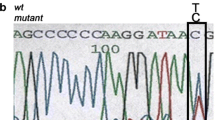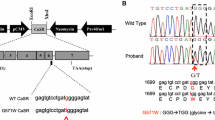Abstract
Identification of variants in the calcium-sensing receptor (CASR) gene is an important means of distinguishing between familial hypocalciuric hypercalcaemia (FHH) and primary hyperparathyroidism. However, identification and bioinformatics analysis of genetic variants alone is now considered insufficient as definitive proof; additional functional assessment is required to diagnose FHH with certainty. We identified two novel variants, D433Y and C739Y, and one previously reported variant G509R in the CASR of four kindreds provisionally diagnosed with FHH and aimed to functionally characterise these variants to confirm the diagnosis. Variant receptors were cloned as FLAG-tagged constructs into the mammalian expression vector, pcDNA3.1. Wild type and variant receptor constructs were expressed in HEK293 cells and their expression assessed by Western blot analysis and their functionality analysed using an IP-One assay which measures myo-inositol 1-phosphate accumulation following CaSR activation. Western blot analysis showed that the D433Y receptor had diminished mature glycosylated receptor compared with wild type CaSR whereas the G509R receptor had a complete lack of mature receptor. The C739Y receptor was consistently overexpressed. Functional assessment showed the D433Y receptor to be mildly inactivating at physiological calcium concentrations whereas the G509R receptor was inactive at all calcium concentrations. By contrast, the C739Y variant was activating compared to wild type receptor which is inconsistent with it causing FHH. We conclude that functional assessment of CaSR variants using the IP-One assay was useful in the investigation of suspected FHH probands, confirming the D433Y and G509R variants as likely pathogenic/pathogenic, but dismissing the C739Y variant as causing FHH.


Similar content being viewed by others
References
Lee JY, Shoback DM (2018) Familial hypocalciuric hypercalcemia and related disorders. Best Pract Res Clin Endocrinol Metab 32:609–619
Ward BK, Magno AL, Walsh JP, Ratajczak T (2012) The role of the calcium-sensing receptor in human disease. Clin Biochem 45:943–953
Jakobsen NFB, Rolighed L, Moser E, Nissen PH, Mosekilde L, Rejnmark L (2014) Increased trabecular volumetric bone mass density in familial hypocalciuric hypercalcaemia (FHH) type 1: a cross sectional study. Calcif Tissue Int 95:141–152
Isaksen T, Nielsen CS, Christensen SE, Nissen PH, Heickendorff L, Mosekilde L (2011) Forearm bone mineral density in familial hypocalciuric hypercalcaemia and primary hyperparathyroidism: a comparative study. Calcif Tissue Int 89:285–294
Magno AL, Ward BK, Ratajczak T (2011) The calcium-sensing receptor: a molecular perspective. Endocr Rev 32:3–30
Brown EM, Gamba G, Riccardi D, Lombardi M, Butters R, Kifor O, Sun A, Hediger MA, Lytton J, Hebert SC (1993) Cloning and characterization of an extracellular Ca2+-sensing receptor from bovine parathyroid. Nature 366:575–580
Pollak MR, Brown EM, Chou YH, Hebert SC, Marx SJ, Steinmann B, Levi T, Seidman CE, Seidman JG (1993) Mutations in the human Ca(2+)-sensing receptor gene cause familial hypocalciuric hypercalcemia and neonatal severe hyperparathyroidism. Cell 31:1297–1303
Hendy GN, Guarnieri V, Canaff L (2009) Calcium-sensing receptor and associated diseases. Prog Mol Biol Transl Sci 89:31–95
Gorvin CM (2019) Molecular and clinical insights from studies of calcium-sensing receptor mutations. J Mol Endocrinol 63:R1–R16. https://doi.org/10.1530/JME-19-0104
Nesbit MA, Hannan FM, Howles SA, Babinsky VN, Head RA, Cranston T, Rust N, Hobbs MR, Heath H III, Thakker RV (2013) Mutations affecting G-protein subunit α11 in hypercalcemia and hypocalcemia. N Engl J Med 368:2476–2486. https://doi.org/10.1056/NEJMoa1300253
Nesbit MA, Hannan FM, Howles SA, Reed AAC, Cranston T, Thakker CE, Gregory L, Rimmer AJ, Rust N, Graham U, Morrison PJ, Hunter SJ, Whyte MP, McVean G, Buck D, Thakker RV (2013) Mutations in AP2S1 cause familial hypocalciuric hypercalcemia type 3. Nat Genet 45:93–97. https://doi.org/10.1038/ng.2492
Stuckey BGA, Kent GN, Gutteridge DH, Pullan PT, Price RI, Bhagat C (1987) Fasting calcium excretion and parathyroid hormone together distinguish familial hypocalciuric hypercalcaemia from primary hyperparathyroidism. Clin Endocrinol 27:525–533
Pollak MR, Brown EM, Estep HL, McLaine PN, Kifor O, Park J, Hebert SC, Seidman CE, Seidman JG (1994) Autosomal dominant hypocalcaemia caused by a Ca2+-sensing receptor gene mutation. Nat Genet 8:303–307
Richards S, Aziz N, Bale S, Bick D, Das S, Gastier-Foster J, Grody WW, Hegde M, Lyon E, Spector E, Voelkerding K, Rehm HL (2015) Standards and guidelines for the interpretation of sequence variants: a joint consensus recommendation of the American College of Medical Genetics and Genomics and the Association for Molecular Pathology. Genet Med 17:405–424
Ward BK, Magno AL, Blitvich BJ, Rea AJ, Stuckey BGA, Walsh JP, Ratajczak T (2006) Novel mutations in the calcium-sensing receptor gene associated with biochemical and functional differences in familial hypocalciuric hypercalcaemia. Clin Endocrinol 64:580–587
Nordin BEC (1978) Diagnostic procedures in disorders of calcium metabolism. Clin Endocrinol 8:55–67
Ward BK, Magno AL, Davis EA, Hanyaloglu AC, Stuckey BGA, Burrows M, Eidne KA, Charles AK, Ratajczak T (2004) Functional deletion of the calcium-sensing receptor in a case of neonatal severe hyperparathyroidism. J Clin Endocrinol Metab 89:3721–3730
Wang K, Li M, Hakonarson H (2010) ANNOVAR: functional annotation of genetic variants from high-throughput sequencing data. Nucleic Acids Res 38:e164. https://doi.org/10.1093/nar/gkq603
Cunningham F, Achuthan P, Akanni W, Allen J, Amode MR, Armean IM, Bennett R, Bhai J, Billis K, Boddu S, Cummins C, Davidson C, Dodiya KJ, Gall A, Giron CG, Gil L, Grego T, Haggerty L, Haskell E, Hourlier T et al (2019) Ensembl 2019. Nucleic Acids Res 47(Database issue):D745–D751. https://doi.org/10.1093/nar/gky1113
Yang H, Robinson PN, Wang K (2015) Phenolyzer: phenotype-based prioritization of candidate genes for human diseases. Nat Methods 12:841–843. https://doi.org/10.1038/nmeth.3484
Arulpragasam A, Magno AL, Ingley E, Brown SJ, Conigrave AD, Ratajczak T, Ward BK (2012) The adaptor protein 14-3-3 binds to the calcium-sensing receptor and attenuates receptor-mediated Rho kinase signalling. Biochem J 441:995–1006
Ward BK, Stuckey BG, Gutteridge DH, Laing NG, Pullan PT, Ratajczak T (1997) A novel mutation (L174R) in the Ca2+-sensing receptor gene associated with familial hypocalciuric hypercalcemia. Hum Mutat 10:233–235
Nissen PH, Christensen SE, Heickendorff L, Brixen K, Mosekilde L (2007) Molecular genetic analysis of the calcium sensing receptor gene in patients clinically suspected to have familial hypocalciuric hypercalcemia: phenotypic variation and mutation spectrum in a Danish population. J Clin Endocrinol Metab 92:4373–4379
Geng Y, Mosyak L, Kurinov I, Zuo H, Sturchler E, Cheng TC, Subramanyam P, Brown AP, Brennan SC, Mun H, Bush M, Chen Y, Nguyen TX, Cao B, Chang DD, Quick M, Conigrave AD, Colecraft HM, McDonald P, Fan QR (2016) Structural mechanism of ligand activation in human calcium-sensing receptor. eLife 5:e13662. https://doi.org/10.7554/eLife.13662
Vargas-Poussou R, Mansour-Hendili L, Baron S, Bertocchio J, Travers C, Simian C, Treard C, Baudouin V, Beltran S, Broux F, Camard O, Cloarec S, Cormier C, Debussche X, Dubosclard E, Eid C, Haymann J, Kiando SR, Kuhn J, Lefort G et al (2016) Familial hypocalciuric hypercalcemia types 1 and 3 and primary hyperparathyroidism: similarities and differences. J Clin Endocrinol Metab 101:2185–2195
Murugaian EE, Premkumar RMR, Radhakrishnan L, Vallath B (2008) Novel mutations in the calcium sensing receptor gene in tropical chronic pancreatitis in India. Scand J Gastroenterol 43:117–121
Ray K, Clapp P, Goldsmith PK, Spiegel AM (1998) Identification of the sites of N-linked glycosylation on the human calcium receptor and assessment of their role in cell surface expression and signal transduction. J Biol Chem 273:34558–34567
Kulkarni A, Mohite M, Vijaykumar R, Bansode P, Murade S, Tamhankar PM (2014) Neonatal severe hyperparathyroidism due to compound heterozygous mutation of calcium sensing receptor (CaSR) gene presenting as encephalopathy. Indian J Pediatr 81:1228–1229
Ho C, Conner DA, Pollak MR, Ladd DJ, Kifor O, Warren HB, Brown EM, Seidman JG, Seidman CE (1995) A mouse model of human familial hypocalciuric hypercalcemia and neonatal severe hyperparathyroidism. Nat Genet 11:389–394
Lienhardt A, Garabedian M, Bai M, Sinding C, Zhang Z, Lagarde J, Boulesteix J, Rigaud M, Brown EM, Kottler M (2000) A large homozygous or heterozygous in-frame deletion within the calcium-sensing receptor's carboxylterminal cytoplasmic tail that causes autosomal dominant hypocalcemia. J Clin Endocrinol Metab 85:1695–1702
Ikegaki N, Gotoh T, Kung B, Riceberg JS, Kim DY, Zhao H, Rappaport EF, Hicks SL, Seeger RC, Tang XX (2007) De novo identification of MIZ-1 (ZBTB17) encoding a MYC-interacting zinc-finger protein as a new favorable neuroblastoma gene. Clin Cancer Res 13:6001–6009
Birnbaum RY, Clowney EJ, Agamy O, Kim MJ, Zhao J, Yamanaka T, Pappalardo Z, Clarke SL, Wenger AM, Nguyen L, Gurrieri F, Everman DB, Schwartz CE, Birk OS, Bejerano G, Lomvardas S, Ahituv N (2012) Coding exons function as tissue-specific enhancers of nearby genes. Genome Res 22:1059–1068
Ray K, Hauschild BC, Steinbach PJ, Goldsmith PK, Hauache O, Spiegel AM (1999) Identification of the cysteine residues in the amino-terminal extracellular domain of the human Ca2+ receptor critical for dimerization. J Biol Chem 274:27642–27650
Ray K, Ghosh SP, Northup JK (2004) The role of cysteines and charged amino acids in the extracellular loops of the human Ca2+ receptor in cell surface expression and receptor activation processes. Endocrinology 145:3892–3903
Guarnieri V, Canaff L, Yun FHJ, Scillitani A, Battista C, Muscarella LA, Wong BYL, Notarangelo A, D'Agruma L, Sacco M, Cole DEC, Hendy GN (2010) Calcium-sensing receptor (CASR) mutations in hypercalcemic states: studies from a single endocrine clinic over three years. J Clin Endocrinol Metab 95:1819–1829
Marx SJ (2019) New concepts about familial isolated hyperparathyroidism. J Clin Endocrinol Metab 104:4058–4066
Ong GSY, Walsh JP, Stuckey BGA, Brown SJ, Rossi E, Ng JL, Nguyen HH, Kent GN, Lim EM (2012) The importance of measuring ionized calcium in characterizing calcium status and diagnosing primary hyperparathyroidism. J Clin Endocrinol Metab 97:3138–3145
Funding
This study did not receive any specific grant from any funding agency in the public, commercial or not-for-profit sector.
Author information
Authors and Affiliations
Corresponding author
Ethics declarations
Conflict of interest
The authors Aaron L Magno, Kassandra M Leatherbarrow, Suzanne J Brown, Scott G Wilson, John P Walsh and Bryan K Ward declare that they have no conflicts of interest in connection with this article. Data associated with the findings reported in this study are available from the corresponding author by request.
Human and Animal Rights
All participants gave informed consent to genetic testing which was performed as part of routine clinical care. Ethical approval for the study was granted by the Committee for Human Rights (University of Western Australia; Project C04).
Additional information
Publisher's Note
Springer Nature remains neutral with regard to jurisdictional claims in published maps and institutional affiliations.
Rights and permissions
About this article
Cite this article
Magno, A.L., Leatherbarrow, K.M., Brown, S.J. et al. Functional Analysis of Calcium-Sensing Receptor Variants Identified in Families Provisionally Diagnosed with Familial Hypocalciuric Hypercalcaemia. Calcif Tissue Int 107, 230–239 (2020). https://doi.org/10.1007/s00223-020-00715-1
Received:
Accepted:
Published:
Issue Date:
DOI: https://doi.org/10.1007/s00223-020-00715-1




